
R Coronae Borealis is a low-mass yellow supergiant star in the constellation of Corona Borealis. It is the prototype of the R Cor Bor class of variable stars, which fade by several magnitudes at irregular intervals. R Coronae Borealis itself normally shines at approximately magnitude 6, just about visible to the naked eye, but at intervals of several months to many years fades to as faint as 15th magnitude. Over successive months it then gradually returns to its normal brightness, giving it the nickname "reverse nova", after the more common type of star which rapidly increases in brightness before fading.

Alpha Coronae Borealis, officially named Alphecca, is an eclipsing binary star in the constellation of Corona Borealis. It is located about 75 light years from the Sun and contains two main sequence stars, one class A and one class G.

T Coronae Borealis, is a recurring nova in the constellation Corona Borealis. It was first discovered in outburst in 1866 by John Birmingham, although it had been observed earlier as a 10th magnitude star.
Mu Ursae Majoris, formally named Tania Australis, is a binary star in the constellation of Ursa Major. An apparent visual magnitude of +3.06 places it among the brighter members of the constellation. Parallax measurements give an estimated distance of roughly 230 light-years from the Sun, with a margin of error of 4%.

Theta Ursae Minoris, Latinized from θ Ursae Minoris, is a suspected binary star system that is visible to the naked eye in the northern circumpolar constellation of Ursa Minor. It is roughly 860 light years from Earth with an apparent visual magnitude of 5.0. The system is moving closer to the Sun with a radial velocity of −25 km/s.

Lambda Ursae Minoris is a star in the constellation Ursa Minor. It is an M-type red giant with an apparent magnitude of +6.38 and is approximately 880 light years from Earth.

S Carinae is a variable star in the constellation Carina.

An R Coronae Borealis variable is an eruptive variable star that varies in luminosity in two modes, one low amplitude pulsation, and one irregular, unpredictably-sudden fading by 1 to 9 magnitudes. The prototype star R Coronae Borealis was discovered by the English amateur astronomer Edward Pigott in 1795, who first observed the enigmatic fadings of the star. Only about 150 RCB stars are currently known in our Galaxy while up to 1000 were expected, making this class a very rare kind of star.
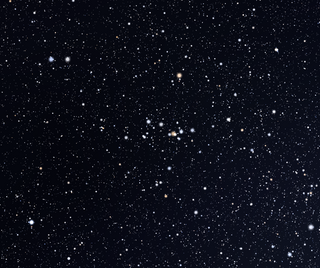
DY Persei is a variable star and carbon star in the Perseus constellation. At maximum it is 11th magnitude and at its faintest it drops to 16th magnitude. DY Persei is the prototype of the very rare DY Persei class of variables that pulsate like red variables but also fade from sight like R Coronae Borealis variables.
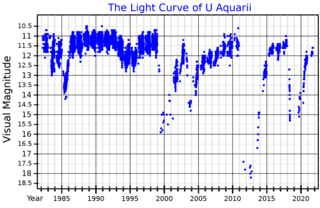
U Aquarii, abbreviated U Aqr, is a variable star in the equatorial constellation of Aquarius. It is invisible to the naked eye, having an apparent visual magnitude that ranges from 10.6 down to as low as 15.9. Based on parallax measurements, the distance to this star is approximately 38 kly (12 kpc). In 1990, W. A. Lawson and associates provided a distance estimate of 43 kly (13.2 kpc) based on the assumption of a bolometric magnitude of −5. It appears to lie several kiloparsecs below the galactic plane, and thus may belong to an old stellar population.
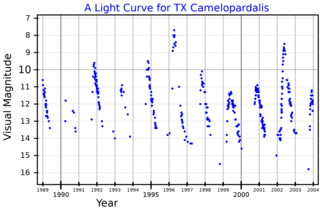
TX Camelopardalis is a Mira-type variable star in the constellation Camelopardalis. It is a classical long period variable star with pulsational period of 558.7 days. Water masers have been observed around the star.

Delta Coronae Borealis, Latinized from δ Coronae Borealis, is a variable star in the constellation Corona Borealis. Its apparent magnitude varies regularly between apparent magnitude 4.57 and 4.69, and it is around 170 light-years distant.

RR Ursae Minoris, abbreviated RR UMi, is a binary star system in the northern circumpolar constellation of Ursa Minor. It can be viewed with the naked eye, typically having an apparent visual magnitude of around 4.710. Based upon an annual parallax shift of 10.0 mas as seen from Earth's orbit, it is located 330 light years away. The system is moving further from the Sun with a heliocentric radial velocity of +6 km/s.

R Leonis Minoris is a Mira variable type star in the constellation Leo Minor. It ranges between apparent magnitude 6.3 and 13.2, and spectral types M6.5e to M9.0e (Tc:), over a period of 372 days.

W Coronae Borealis is a Mira-type long period variable star in the constellation Corona Borealis. Its apparent magnitude varies between 7.8 and 14.3 over a period of 238 days.
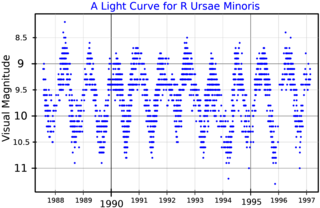
R Ursae Minoris is a star in the constellation Ursa Minor. A red giant of spectral type M7IIIe, it is a semiregular variable ranging from magnitude 8.5 to 11.5 over a period of 325 days.

S Ursae Minoris is a long period variable star in the constellation Ursa Minor, ranging from magnitude 7.5 to fainter than 13.2 over a period of 331 days.

S Apodis, also known as HD 133444 is a variable star located in the southern circumpolar constellation Apus. It has an apparent magnitude ranging from 9.6 to 17, which is below the limit for naked eye visibility. The object is located relatively far at a distance of approximately 15,000 light years based on Gaia DR3 parallax measurements, but it is drifting closer with a heliocentric radial velocity of −75 km/s.
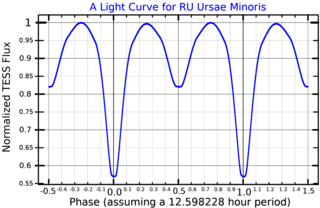
RU Ursae Minoris is a binary star system in the constellation Ursa Minor. Its apparent magnitude ranges from 10 to 10.66 over 0.52 days as one star passes in front of the other relative to observers on Earth. Its component stars were calculated to be a primary star of spectral type F0IV/V and a secondary of spectral type K5V, both slightly more luminous than their spectral types indicate. The system is semidetached, as the secondary star is filling its Roche lobe and transferring matter to the primary. The primary is between 2.2 and 2.3 times as massive as the Sun, with 1.8 times its radius and around 8 times its luminosity. The secondary has around 0.72 times the Sun's mass, 1.1 times its radius and between 0.58 and 0.86 times its luminosity.
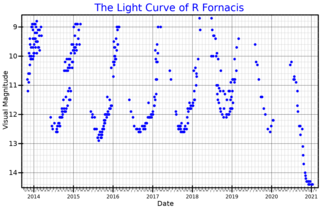
R Fornacis is a Mira variable and carbon star located in the constellation Fornax. It is around 1,800 light years away based on parallax measurements.


















